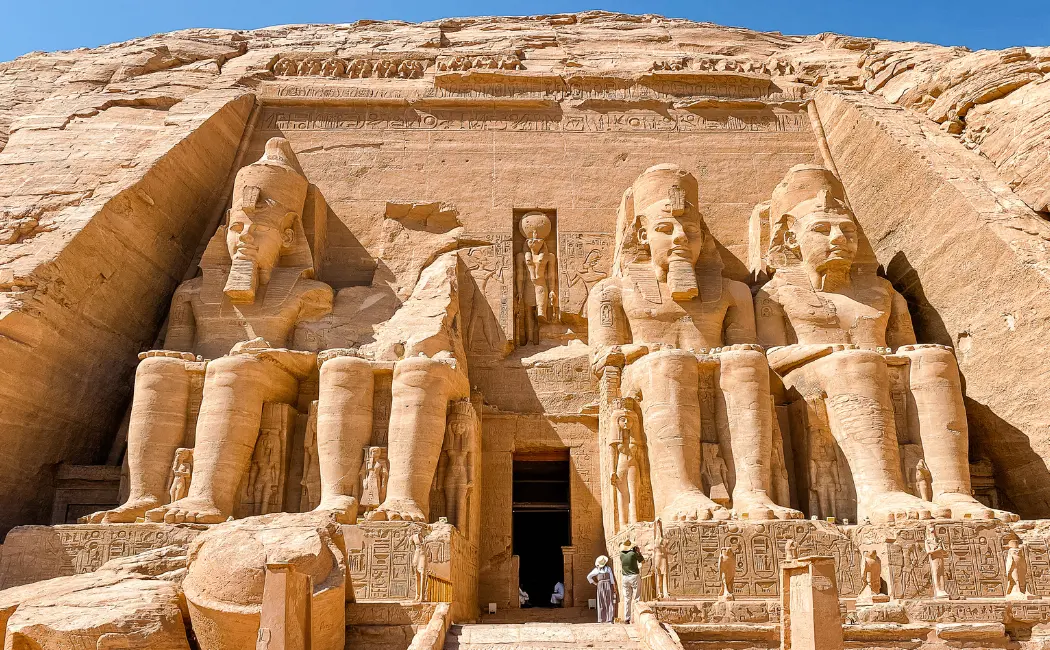Deep within the Egyptian desert, nestled beside the tranquil waters of Lake Nasser, stand the majestic Abu Simbel Temples.
These ancient rock-cut structures, crafted by Pharaoh Ramses II in the 13th century BC, are a testament to Egypt’s rich history, architectural ingenuity, and cultural heritage.
You May Also Like: Prem Mandir: Where Love and Devotion Meet
History and Significance
The Abu Simbel Temples were constructed to honor the gods Amun and Ra, and to commemorate Ramses II’s military victories.
The temples were carved directly into the sandstone cliffs, ensuring their durability and protection from the harsh desert environment.
The Great Temple
The larger of the two temples, the Great Temple, stretches 30 meters into the mountain. Its facade features four colossal statues of Ramses II, each standing 20 meters tall.
The temple’s interior boasts vivid wall paintings and intricate reliefs, depicting scenes from Egyptian mythology and Ramses II’s battles.
The Small Temple
The smaller temple, dedicated to Nefertari, Ramses II’s beloved wife, showcases stunning artwork and sculptures.
Its facade features two statues of Nefertari, standing 10 meters tall, alongside statues of Ramses II.
Engineering Marvel
The Abu Simbel Temples’ relocation, orchestrated by UNESCO in the 1960s, is an engineering feat.
The temples were dismantled and rebuilt 60 meters higher and 180 meters inland to avoid submersion by Lake Nasser, created by the Aswan Dam.
Preservation Efforts
Ongoing preservation efforts ensure the temples’ longevity:
- UNESCO World Heritage Site: Designated in 1979.
- Egyptian Ministry of Antiquities: Collaborative conservation initiatives.
- International Funding: Supporting restoration projects.
Visiting Abu Simbel
Address: Abu Simbel, Aswan Governorate, Egypt
Opening Hours: 6:00 AM – 5:00 PM
Tickets: Available on-site or online
Tips and Precautions
- Respect Local Customs: Dress modestly and remove shoes when entering temples.
- Sun Protection: Wear sunscreen, hats, and sunglasses.
- Guided Tours: Recommended to fully appreciate the temples’ history and significance.
Conclusion
The Abu Simbel Temples are an awe-inspiring testament to ancient Egypt’s architectural prowess and cultural heritage.
These majestic structures continue to captivate visitors from around the world.
Key Facts
- Constructed: 1264 BC
- Relocated: 1964-1968
- Architectural Style: Rock-cut
- Length: 100 meters (Great Temple)
- Height: 30 meters (Great Temple)
References
- Official Abu Simbel Temples Website
- Egyptian Ministry of Antiquities
- UNESCO World Heritage Centre











Great insights! I found your take on sustainable living incredibly practical. Looking forward to implementing some of these tips! Check out [Get Info](https://getinfo.ink/?utm_source=google&utm_medium=search&utm_campaign=promotion) for more inspiring content.
Great insights! I found your take on sustainable living incredibly practical. Looking forward to implementing some of these tips! Check out [Get Info](https://getinfo.ink/?utm_source=google&utm_medium=search&utm_campaign=promotion) for more inspiring content.